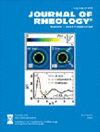Viscous effects in sheared unsaturated wet granular materials
IF 3
2区 工程技术
Q2 MECHANICS
引用次数: 0
Abstract
We report on experiments and discrete element simulations of homogeneous, simple, normal stress-controlled, shear flows of model unsaturated granular materials: assemblies of frictional spherical particles bonded by a small quantity of a wetting liquid. The rheology of such unsaturated granular materials in the dense flow regime was characterized in recent publications of our group, in terms of internal friction coefficient μ∗ and solid fraction Φ, depending on the reduced pressure P∗ comparing capillary forces to controlled normal stress, and on inertial number I. The present study extends this description to the influence of the liquid viscosity on material rheology in the low saturation regime. The quantitative agreement of simulations with experiments is confirmed for the quasistatic limit, and our numerical results, despite some quantitative differences, capture the correct trends in the regime dominated by viscous forces. Rheological properties are then determined, to a large extent, by the same viscous numberIv as used to formulate constitutive laws in saturated, dense suspensions. More precisely, a visco-inertial numberJ, combining Iv with inertial number I as J=Iv+2I2, appears apt to describe the rheological laws, as expressed by the internal friction coefficient and the solid fraction, measured in the laboratory or in the simulations, as well as the numerically investigated internal state of the flowing material. Simulations provide insight into the role of viscous forces: predominantly tensile, they contribute to the increase with shear rate of the macroscopic friction coefficient μ∗ through a direct positive contribution to shear stress, a negative contribution to normal stresses (enhancing the strength of the contact network), and microstructural changes affecting the network of contacts and liquid bridges.剪切非饱和湿颗粒材料中的粘性效应
我们报告了对模型非饱和颗粒材料(由少量润湿液体粘合的摩擦球形颗粒集合体)的均匀、简单、法向应力控制的剪切流的实验和离散元模拟。我们课题组最近发表的论文描述了这种非饱和颗粒材料在密流状态下的流变特性,即内摩擦系数μ∗和固体分数Φ,取决于毛细管力与受控法向应力比较的减压P∗和惯性数I。在准静态极限下,模拟与实验的定量一致性得到了证实,尽管存在一些定量差异,但我们的数值结果捕捉到了粘性力主导机制下的正确趋势。流变特性在很大程度上是由用于制定饱和致密悬浮液构成定律的相同粘性数 Iv 决定的。更准确地说,粘惯性数 J(将 Iv 与惯性数 I 结合为 J=Iv+2I2)似乎可以描述流变学规律,如实验室或模拟中测量的内摩擦系数和固体分数,以及数值研究的流动材料内部状态。通过模拟可以深入了解粘滞力的作用:粘滞力主要是拉伸力,通过对剪切应力的直接正向作用、对法向应力的负向作用(增强接触网的强度)以及影响接触网和液桥的微观结构变化,使宏观摩擦系数μ∗随剪切速率的增加而增加。
本文章由计算机程序翻译,如有差异,请以英文原文为准。
求助全文
约1分钟内获得全文
求助全文
来源期刊

Journal of Rheology
物理-力学
CiteScore
6.60
自引率
12.10%
发文量
100
审稿时长
1 months
期刊介绍:
The Journal of Rheology, formerly the Transactions of The Society of Rheology, is published six times per year by The Society of Rheology, a member society of the American Institute of Physics, through AIP Publishing. It provides in-depth interdisciplinary coverage of theoretical and experimental issues drawn from industry and academia. The Journal of Rheology is published for professionals and students in chemistry, physics, engineering, material science, and mathematics.
文献相关原料
| 公司名称 | 产品信息 | 采购帮参考价格 |
|---|
 求助内容:
求助内容: 应助结果提醒方式:
应助结果提醒方式:


